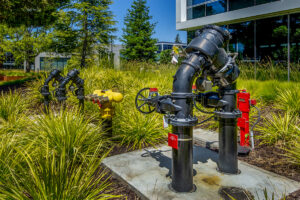
How do backflow devices protect your drinking water? Don’t neglect these important plumbing systems!
When it comes to ensuring the safety and cleanliness of your home’s water supply, backflow prevention is a critical component. While most people assume the water coming from their tap is safe to drink, plumbing issues can cause contamination without warning. That’s where backflow devices protect your drinking water and safeguard your family’s health.
What Is Backflow?
Backflow is a plumbing term that refers to the unwanted reversal of water flow in your pipes. This reverse flow can cause contaminated water—often from irrigation systems, pools, or industrial fluids—to enter your clean water supply. Backflow typically happens due to a sudden change in pressure, such as a burst pipe or a significant demand from the municipal water line.
When backflow occurs, dangerous contaminants like pesticides, fertilizers, human waste, or chemicals can seep into the potable water supply. That’s why municipalities require backflow prevention systems in many residential, commercial, and industrial settings.
How Backflow Devices Work
Backflow prevention devices are mechanical valves installed at specific points in your plumbing system. These devices are designed to allow water to flow in only one direction—into your home—and block any flow that tries to reverse.
There are several types of backflow prevention devices, including:
- Atmospheric vacuum breakers (AVBs)
- Pressure vacuum breakers (PVBs)
- Double check valve assemblies (DCVAs)
- Reduced pressure zone (RPZ) assemblies
Each type is suited for different levels of risk and system setups. A licensed plumber can help you determine which device is best for your property.
Why Backflow Devices Protect Your Drinking Water
The primary function of a backflow device is to act as a gatekeeper between contaminated sources and your clean drinking water. Here’s how backflow devices protect your drinking water effectively:
- Prevents health hazards: They stop pollutants, bacteria, and harmful chemicals from entering your water supply.
- Ensures compliance with local regulations: Many municipalities require annual testing of backflow prevention devices to stay compliant.
- Protects plumbing infrastructure: Contaminants from backflow can corrode pipes and damage appliances, leading to costly repairs.
- Peace of mind: Knowing your family’s water is safe from contamination offers long-term confidence and security.
Who Needs a Backflow Prevention Device?
While backflow prevention is often associated with commercial or industrial buildings, many residential homes need them too—especially if they have:
- Underground irrigation or sprinkler systems
- Swimming pools or hot tubs
- Private wells or water tanks
- Fire suppression systems
- Complex plumbing systems with multiple connections
If you’re unsure whether your property needs a backflow prevention device, schedule a consultation with a certified plumber or your local water authority.
Regular Testing and Maintenance Are Key
Installing a backflow prevention device is just the first step. To ensure ongoing protection, most municipalities require these devices to be tested annually by certified professionals. Regular maintenance ensures the device is working correctly and helps catch any signs of wear or failure before problems arise.
Call Mahon Plumbing Today
If you still have more questions regarding your plumbing, we here at Mahon Plumbing are here to help. We have been serving the wider Baltimore area since 1994, so we have 25 years of experience to back up our fantastic service! Call us at our Baltimore location at 410-766-8566 or our Pasadena location at 410-636-7944. Be sure to keep up with us on social media by following us on Facebook or Twitter.
